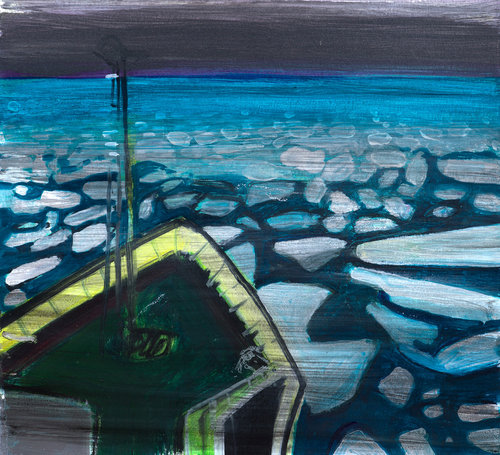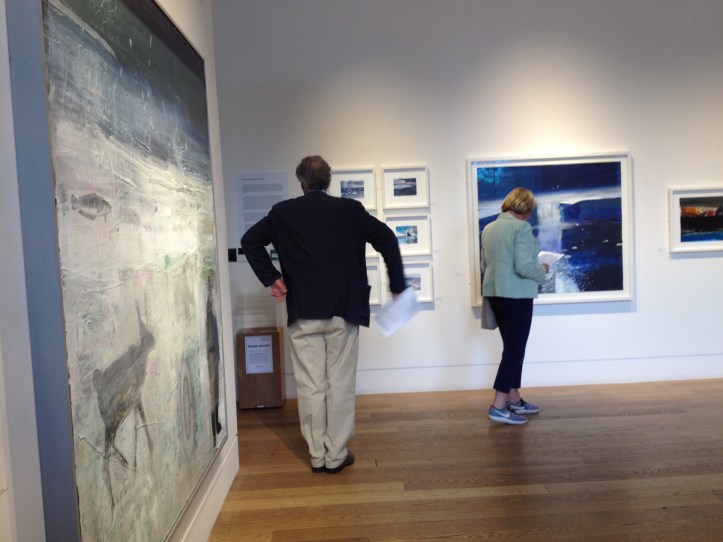Reasons to go to the RSA Edinburgh exhibition “Barbara Rae: the North-West Passage”: because you are interested in large paintings, the Arctic, the Inuit, prints, landscapes, ice floes, water, beauty, environmental issues, global warming, the colour blue or because you want to feel cool on a hot day.

I visited the opening of this exhibition today, and it is a stunner. As fits its subject, there are huge prints, paintings on paper and giant mixed media canvases with water-based mediums, in every shade of blue – but also vibrant, astonishing pinks and oranges and other colours.
The pictures spread throughout the bottom floor of the Royal Scottish Academy: three main rooms and along a corridor into the President’s Room.
To walk through the exhibition is to be taken on a visual visceral voyage into an area of the world where few venture: an icy wilderness.
Opening Room, Opening Day
The pictures begin in the Academicians’ room (from the main entrance, down the stairs and to the right). We get the history which enticed Barbara Rae to the subject: a famous polar explorer and mapper, Sir John Rae, (no relation), who was part of an Arctic expedition recovering a lost earlier expedition – he controversially found signs of cannibalism among that ship’s crew. At the same time, he behaved with respect to the local Inuit, including drawing how to angle ice blocks correctly, to build an igloo.

Here in the opening room, there is the large and powerful painting which was chosen as the identifying image for the entire exhibition: the T-line of white against the richest, darkest blue. Also, the sketchbooks with large, generous black ink writing, in a showcase.
 Also, the Aberdeen Inuit collection has kindly loaned various artefacts: sealskin boots and carven ivory figures, which give a flavour of the historical expeditions and what they found.
Also, the Aberdeen Inuit collection has kindly loaned various artefacts: sealskin boots and carven ivory figures, which give a flavour of the historical expeditions and what they found.

There are also silently playing video clips, in several places throughout, bringing the sense of the reality of the environment, as experienced through a digital lens.
But it is the large paintings which take your breath away and give that sense of wateriness and ice, geology and life. Occasional pictures have faint images of people paddling a canoe in the bottom, occasionally there are vestiges of local animals, a few paintings of apparently empty hut. But the landscape is all, signs of human presence are negligible. There is a vast silence.
You will likely want to view more at the Academy’s website:
Viewer Experience
The best experience is to actually go, sit in front of the huge canvases for a little, absorb the sense of scale and silence. For example, the picture shown above, doesn’t look as overwhelming as it is displayed in the central room: because the green/gold hill in the middle glows startlingly vibrantly in its own canvas and the room; you need to see it in person.
The canvases are often mixed media, so they are a whole landscape of edges and ledges and depths in themselves, which you can only appreciate by viewing them up close, or at an angle. Paper has been painted on, then applied to the canvas surface. Very occasionally, there is handwriting in the picture too, or a sense of ecology in the lower section or a sense of man’s exploration. But these edgings are just that, only at the fringes, not central to the mysterious image in the middle: the Polar landscape.
I warmly recommend exploring this exhibition in the weeks it is here. Set aside time for this – it is large, generous and sprawling, and you may be surprised by what takes your fancy. There are intriguing small study paintings on paper, as well as medium sized and then massive.
One especially pleasing benefit is that it feels cool when the air outside is hot: all the ice and deep blue, against plain white walls, in rooms away from the bright sunlight. A great location for the showing, and the perfect time of year – in dreich winter light, it would feel too cold.
From Afar
If you live so far away that you can’t visit, there is a reasonably priced handsome hardback book with many pictures, available from the RSA. You just need to imagine the size of some of the largest pieces – huge windows into another, faraway world.





[…] who had similarly been vastly disappointed by accidentally losing two on a flight. (see here for my review of Barbara’s extensive polar pictures exhibition at RSA in […]